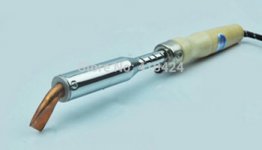Part of my current project involves zinc tops to a bookcase and desk. I've got the zinc laminated onto some plywood, and the corners are mostly formed.
My understanding is that finishing the corners involves soldering them with some zinc solder and then filing that down to create a finished look.
Where I'm running into some trouble is that I can't seem to get the solder to flow. I'm using an Aoyue 469 60w iron, which is supposed to get pretty hot. Even turned up all the way, it doesn't seem to be doing a great job melting the solder. I've tried warming up the surrounding metal with a heat gun.
Anyone here have any suggestions about what I could do to get this to work?
-Adam
My understanding is that finishing the corners involves soldering them with some zinc solder and then filing that down to create a finished look.
Where I'm running into some trouble is that I can't seem to get the solder to flow. I'm using an Aoyue 469 60w iron, which is supposed to get pretty hot. Even turned up all the way, it doesn't seem to be doing a great job melting the solder. I've tried warming up the surrounding metal with a heat gun.
Anyone here have any suggestions about what I could do to get this to work?
-Adam

